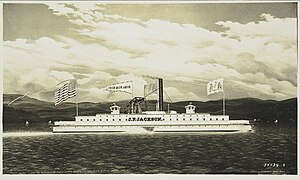 John P. Jackson as portrayed in 1860
| |
| History | |
|---|---|
| Name | John P. Jackson |
| Builder | Devine Burtis, Brooklyn, New York |
| Launched | 2 August 1860 |
| Acquired | 6 November 1861 |
| Commissioned | 14 February 1862 |
| Decommissioned | 5 September 1865 |
| Fate | Sold, 27 September 1865 |
| Notes | Civilian merchant use postwar; disappeared from shipping records in 1871 |
| General characteristics | |
| Tons burthen | 750 |
| Length | 192 ft (59 m) |
| Beam | 36 ft 6 in (11.13 m) |
| Depth of hold | 12 ft (3.7 m) |
| Propulsion | steam engine, side wheel-propelled |
| Complement | 99 |
| Armament |
|
| Notes | Sawyer rifle replaced with 100-pounder Parrott rifle in July 1864 |
USS John P. Jackson was a sidewheel steamer acquired by the Union Navy during the beginning of the American Civil War. Built in 1860, John P. Jackson was used as a ferry by the New Jersey Rail Road and Transportation Company. In February 1861, she ferried President-elect Abraham Lincoln on his way to his inauguration. She was purchased for use in the American Civil War on 6 November. Commissioned for military service on 14 February 1862, she was sent to Ship Island. On 4 April, she was part of a battle with Confederate vessels near Pass Christian, Mississippi. That same day, she captured the blockade runner P. C. Wallis. In April, she bombarded Confederate-held Fort Jackson and Fort St. Philip. Next month, John P. Jackson participated in a scout of Lake Pontchartrain.
After moving up the Mississippi River towards Vicksburg, Mississippi, John P. Jackson was damaged by Confederate fire on June 28. She was transferred to the Mississippi Sound on 30 September, where she served on the Union blockade through the following year and captured several prizes. In February 1864, she was part of a bombardment of Confederate-held Fort Powell at Mobile Bay, and during the Battle of Mobile Bay on 5 August, again bombarded Fort Powell. She spent the rest of the war on blockade duty. After the war ended, she was sold at New Orleans, Louisiana, to Marcy, Maury & Co. for $13,500. After the war, she was used as a merchant vessel under J. P. Jackson, disappearing from shipping records in 1871.